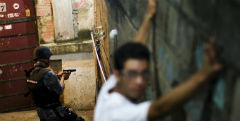Heavily armed “mega-gangs” are terrorizing swathes of Venezuela, say experts, in the latest indication the country’s criminal chaos may be converging around more organized structures.
The Venezuelan Organized Crime Observatory has released an alert highlighting the growing strength of criminal structures it calls “mega-gangs.” Each consists of around 50 core members but can call on a network of up to 200 criminals through connections with local street gangs.
The mega-gangs’ principal criminal activities are extortion, kidnapping, hijackings, robbery, murder-for-hire and petty drug trafficking. The gangs are much more heavily armed than common street gangs, and use weaponry such assault rifles and fragmentation grenades.
The observatory says the mega-gangs are not an evolution of smaller street gangs, but instead are based on the criminal model developed in Venezuela’s prisons, where leaders known as “pranes” hold sway over hierarchically organized structures. Several of the gangs are controlled from within prison by such figures. (See the Observatory list of mega-gangs here – pdf).
SEE ALSO: Venezuela News and Profiles
The Venezuelan government, meanwhile, has conflated such structures with Colombian-style paramilitaries, and last week launched the Bolivarian National Guard (GNB) operation “Liberation of the People” to target these networks, reported El Nacional.
However, the operation got off to a bad start: within days of its launch, family members of people who had been detained by the GNB as part of the operation staged a protest claiming the detainees were innocent and denouncing the GNB for extortion, robbery and threatening residents.
InSight Crime Analysis
In contrast to regional neighbors such as Colombia or Mexico, where powerful transnational criminal and insurgent networks have fueled violence, Venezuela’s security crisis has always been more chaotic.
However, from within this chaos, ever more organized structures have been emerging to capitalize on the gaps left by corrupt and incapable security and justice institutions. These range from the drug trafficking network of corrupt military officials known as the “Cartel of the Suns,” to the armed radical political collectives that hold sway in urban slums. The mega-gangs may prove to be another collective.
SEE ALSO: Cartel of the Suns Profile
According to the Organized Crime Observatory, two state policies in particular have facilitated their growth. The first of these is the “peace zones,” where security forces have no permanent presence, allowing criminal structures to flourish. The second is the militarization of security, which has weakened the police and helped criminals source heavy weapons after coming into contact with corrupt military officials.

